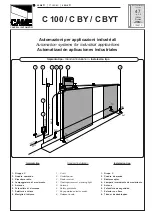
37
© 2012 Installation and Reference Manual D0125 Rev. H
Section 4
—Installing Photoelectric (non-contact) Sensors – continued
Supervised Connection
If the photo eye being installed has a true NC output (one that is NC when the photo eye is powered, aligned and set for
Light Operate), then a supervised connection is recommended. A supervised connection will signal a system Fault and
prevent gate operation if either the open or close photo eye connection ever becomes an open circuit or a short circuit.
The Installer Menu item [PC_0] must be changed to [PC_1] to enable this feature. See Installer 18 on page 27.
Photo Eye Function
If the gate is not in motion, a tripped photo eye will prevent the gate from starting in either direction.
If tripped
while in motion, the gate pauses, and then automatically restarts again if the photo eye is cleared within five seconds. An
optional setting in the Installer Menu causes a two-second reversal of travel. See Installer Menu 14 & 15 starting on page
27.
Alignment
Most photo eyes require careful optical alignment in order to aim the emitter beam to the center of the receiver or
reflector. To avoid false triggering, it is important to carefully align the system, especially with retro-reflective photo eyes.
The best way to assure true centering of the beam is with some trial testing where the emitter is shifted to move the beam
left and right and up and down until the range of the invisible cone of the infrared beam is known. Photo eyes usually
provide alignment aid LED’s for this setup, but they can be hard to see. HySecurity has provided a unique feature that
turns power on to the photo eyes and causes our buzzer to chirp when the photo eye enters and exits alignment. See
User Menu item 9 on page 26
t
o enable this feature. Set the menu item [PE_0] to [PE_1] and the buzzer will chirp twice
when the beam is broken and once when remade. (The parameter will automatically reset the next time the Close Limit
Switch is triggered.)
Notes about Retro-Reflective Systems
Correct installation and alignment of a retro-reflective photo eye and its reflector is important for a trouble free installation.
Any system operating at a range greater than 16 feet is more prone to false triggering due to dirty optics, condensation or
poor weather. If care is taken in the initial mounting and alignment of the 3-inch reflector, the chance of problems is
greatly reduced.
Taking steps to protect the photo eye and the reflector from being exposed to fog and being absolutely certain the photo
eye is perfectly aligned will greatly reduce any false triggering of the system. The ideal mounting of a retro-reflective photo
eye is inside an enclosure.
The ideal mounting for the reflector is suspended inside a twelve inch long piece of 3-inch PVC conduit. Cut the opening
of the PVC conduit at a 45-degree angle to act as a drip shield. Hold the reflector against the backside of the PVC conduit
by attaching a 3-inch male connector. Do not cement the connector. This would prevent the reflector from being reached
for future cleaning. To create a mounting base, attach a 3-inch aluminum flange (electric meter hub) to the connector. This
whole package can be mounted to any flat surface.
Locate the reflector in the center of the invisible beam of infrared light to achieve the most sensitive alignment. The beam
center is determined by the following test: while holding the reflector in your hand, slowly raise it until the beam is no
longer returned and the photo eye trips. Mark this maximum height. Now lower your hand and determine the lower limit of
the infrared beam by watching for the trip point. Mark this position as well. Repeat the same procedure for left and right at
the center elevation of the beam, as determined by the previous test. Once the four limits have been determined, either
mount the reflector in the center of the area outlined or realign the eye for the position of the reflector. If the photo eye is
realigned, be sure to perform the centering test again to verify that the reflector is truly in the center.
Summary of Contents for SlideDriver 50VF2
Page 2: ......
Page 28: ...14 2012 Installation and Reference Manual D0125 Rev H Section 2 Technical Drawings...
Page 29: ...15 2012 Installation and Reference Manual D0125 Rev H Section 2 Technical Drawings...
Page 36: ...22 2012 Installation and Reference Manual D0125 Rev H Section 3 Wiring Control Inputs...
Page 63: ...49 2012 Installation and Reference Manual D0125 Rev H Section 6 Internal Solenoid Lock Drawing...
Page 64: ...50 2012 Installation and Reference Manual D0125 Rev H Section 6 Internal Solenoid Lock Drawing...
Page 81: ...68 2012 Installation and Reference Manual D0125 Rev H...
















































